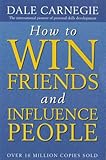
As most people grow in maturity they realise that to improve themselves and advance their position in life, time needs to be spent analyzing faults and setting aside a little time to correct errant habits. Despite the years accumulated by millions of people reclining in quiet reflective introspection, there is still one primal instinct that even the most educated scholar will succumb to – Schadenfreude. Anyone who has experienced the childhood mortification of dozens of peers convulsing with laughter at your misfortune understands with painful clarity the double-edged sword of social interaction; by laughing at someone in distress you tempt the gods to smite you with something even more tragically humourous.
It was with this in mind that I carefully hid the cover of Dale Carnige’s 1937 bestseller “How to win friends and influence people” from everyone and anyone around me. This book has the unfortunate side-effect of convincing random passersby that the reader is a social pariah who is both unable to make friends and who also cannot influence people. The adjusted cover of “How to burn orphanages” ensured that I was free from literary shouldersurfers on the bus home.
Before I read this book I would have dismissed it as a cynical manual to allow manipulative conmen to talk old ladies out of their retirement money. Thankfully this is not the case. Dale Carnige presents a few common sense concepts to allow you to see the best in the people you interact with. Whats more, the slightly archaic language of the book makes for a very amusing read. Pedestrian anecdotes take on a brand new sheen when your inner monologue has been convinced you are listening to the advice of Montgomery Burns.
The book is divided into three main areas: Fundamental techniques in handling people, ways to make people like you, and ways to win people to your way of thinking. Within a business context it is critical to be able to convince people of the validity of your ideas; whether giving an “elevator pitch” to a potential investor on a chance encounter or as a manager trying to convince their team to take a certain direction. Countless tomes have been written on developing “rapport” with people in an attempt to sell them something, the author of this book has taken a much simpler tack; if you want people to like you, why not be a likeable person?
- Become genuinely interested in other people – Instead of adopting cynical tactics to garner someone’s approval, why not really try to understand their point of view? Take a step back and understand the person behind the role they fulfill. It should be rewarding in itself. People are interesting.
- Don’t criticize, condemn, or complain – Nobody likes a moaner. If you are constantly promoting negative qualities you will be seen in a negative light, the sort of person who seems to carry a “dark cloud” around with them. If you need to bring up a negative issue try to express it in terms of what the required action is rather then what someone did wrong. Convert criticism into useful suggestions.
- If you are wrong, admit it quickly and emphaticially – There is nothing more infuriating then someone who is never wrong, even when all the evidence points to the contrary. You learn from your mistakes; no mistakes – no learning. Admitting your faults affords those around you the luxury of making mistakes themselves.
- Get the other person agreeing early – If you are trying to persuade someone of the merits of an idea, start off small. Have them agree to the minor points of discussion, and build up more agreement before moving towards the main point you need approval for. The process of saying “yes, yes” pushes them into a positive frame of mind.
This book is a thoroughly enjoyable read – an original “feel-good” book. Whether or not I’m making more friends or influencing more people as a result of it, the concepts it espouses are genuinely worth understanding. In a world of constant communication, lessons such as these are invaluable.
One thought on “Book Review: How to Win Friends and Influence People”